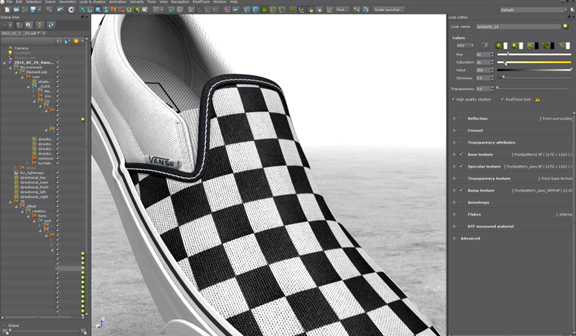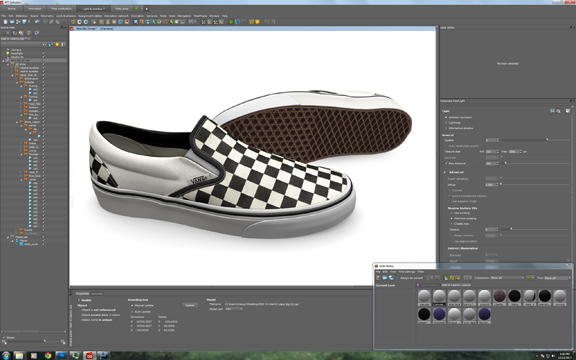Latest News
March 11, 2014
The iconic shape of the flat-bottomed skateboard shoe hasn’t changed much, but the way it’s designed and manufactured may be drastically changing.
Until about two years ago, Vans, a brand of the footwear and apparel company VF, relied on traditional artist sketches and physical sample units to develop new products. But the automakers’ migration from physical to digital prototypes caught Vans’ attention.
Safir Bellali, director of design innovation, Vans Footwear, recalled, “[Our parent company] determined that Vans would be a good brand to pilot the virtualization program with and started investing in the tools to pursue this initiative. We are obviously not the first one [in the footwear industry] to engage in virtualization, but we’re the first of the VF brands to do that.”
The result was a process overhaul, leading to digital prototyping in DeltaGen, DeltaTex, and PictureBook software from RTT (acquired by Dassault Systemes last December); 3D modeling in Alias, Rhino, SolidWorks, and RomansCAD (for footwear); and shape capturing with Geomagic. The software lineup is supported by Mac Pro and HP workstations equipped with NVIDIA Quadro GPUs and rapid prototyping machines.
“In automotive, generating CAD geometry has long been the traditional approach,” Bellali observed. “That is not the case with footwear.” The main hurdle, he pointed out, was “the change in perception that we could use and implement a technology that was initially meant for the automotive industry.” Therefore, the investment to acquire the 3D modeling software and the talent necessary to move to digital prototyping was nothing short of a leap of faith for Vans.
Certain shoe components—such as injection-molded parts—are designed in CAD programs, but the rest of the design was usually proposed, reviewed, and approved in paper sketches and vector drawings with dimensions, often with sample fabric and swatches attached. The factory would build physical mockups, or sample units of shoes, based on the drawings. “The process was not an exact science,” noted Bellali. “When you go straight from 2D drawings to 3D, there’s a lot of interpretations. A 3D model, on the other hand, gives you exactly what the model looks like.”
With the 2D process, it took two to three weeks to transform the drawing into a physical prototype. Each revision added two to three more weeks to the cycle. “[Designs] could involve up to two or three revisions, so you’re looking at three to four months to get to the point where you’re confident that the sample built matches the designer’s vision,” estimated Bellali.
Today, with 3D CAD design and 3D printing, Vans has cut down the concept-to-prototype phase to a week or two. “At that rate, we could get a finished product in about four weeks, instead of four months,” said Bellali.
Most projects begin with the shape of an existing shoe model. For that phase, Vans relies on Geomagic software to convert scanned point-cloud data into editable surfaces.
“There are a number of collateral benefits we’ve experienced, from generating marketing assets faster and with more flexibility than before, to creating new ways for the consumer to interact with our product,” Bellali added. Vans’ current online catalog features digital photos of shoes and animated Gifs to simulate rotatable 3D models for consumers to inspect the models and shop. But Vans vision is to implement online configuration and visualization features driven by 3D CAD models.
One of the principle 3D visualization and rendering software—RTT’s DeltaGen—is “power-hungry,” in Bellali’s words. Because of RTT’s partnership with GPU maker NVIDIA, Vans can deploy DeltaGen in the GPU-accelerated mode, producing ray-traced scenes that accurately depict how the shoes will look when manufactured. “Without [GPU acceleration], we’d have to hit the render button and wait for several hours to get a photo-realistic image,” said Bellali. “But with this, it’s pretty close to real time. We can manipulate [spin, rotate, zoom in, and so on] the 3D model with textures and materials in real time without any constraints.”
As footwear, the skateboard shoe is not a technologically complex piece of engineering, Bellali pointed out. At its core, it still remains canvass and rubber, bind in a simple form. But that time-tested simplicity remains the ideal method to give the skateboarder the most control over his or her board.
“[Virtualization] is not about creating a futuristic-looking skateboarding shoe,” said Bellali. “[Vans shoes] are still an expression of authenticity and heritage.” The new manufacturing tradition is to speed up Vans ability to refine and deliver the classic skateboarding shoe, not to invent something new.
Bellali is scheduled to deliver a talk on this topic at upcoming NVIDIA GTC (March 24-17, San Jose, San Francisco). To attend, look for “S4658: Rethinking the Skateboard Shoe.”
Subscribe to our FREE magazine, FREE email newsletters or both!
Latest News
About the Author
Kenneth Wong is Digital Engineering’s resident blogger and senior editor. Email him at [email protected] or share your thoughts on this article at digitaleng.news/facebook.
Follow DE







